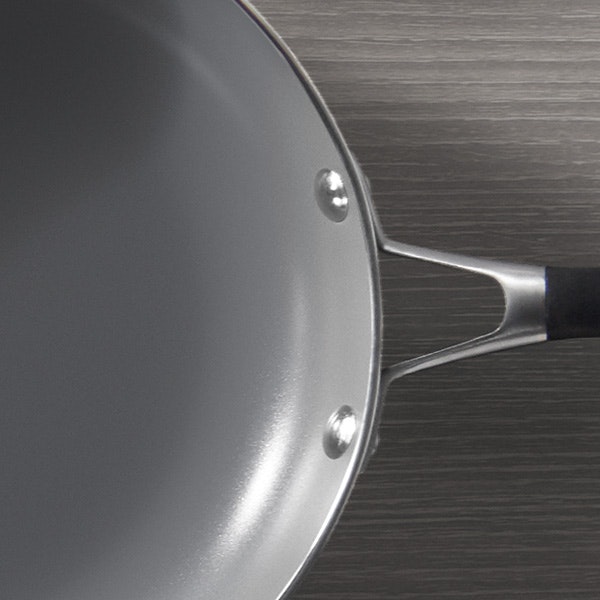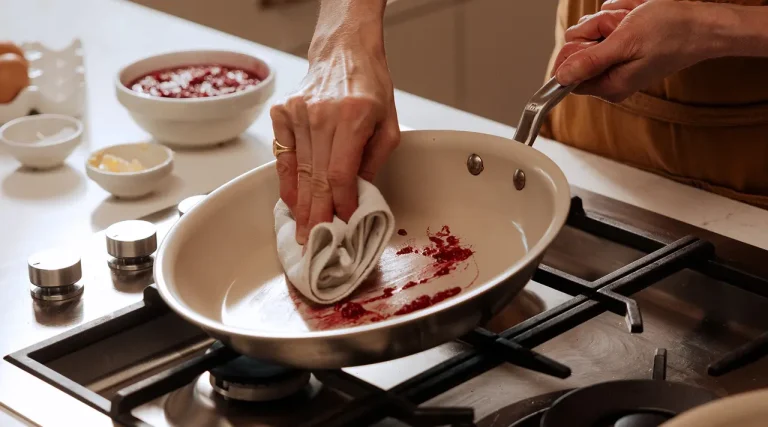Ceramic cookware is a fantastic addition to your kitchen. It’s not only stylish and versatile but also offers a healthier way to cook.
However, to keep your ceramic pots and pans in top shape, proper cleaning and storage are crucial. Imagine serving a perfectly cooked meal without any hassle or worry about damaging your favorite cookware. You deserve cookware that lasts and performs beautifully every time you use it.
That’s why understanding the right techniques for cleaning and storing ceramic cookware is essential. You’ll discover simple yet effective tips that ensure your ceramic cookware stays pristine and ready for your culinary adventures. Let’s dive in and make sure your cookware remains as reliable as the day you bought it.
Ceramic Cookware Basics
Ceramic cookware offers a unique blend of beauty and function. It is known for its smooth surface and even cooking. Many home chefs appreciate its non-stick qualities. Understanding ceramic cookware is essential for proper care.
Ceramic comes in different types and styles. Each type has specific features. Some are pure ceramic, while others have coatings. Knowing your cookware type ensures better maintenance and cooking results.
What Is Ceramic Cookware?
Ceramic cookware is made from clay and minerals. It is baked at high temperatures. This process gives it a hard surface. Ceramic can be glazed or unglazed. Glazed ceramic has a shiny, protective layer.
Benefits Of Ceramic Cookware
Ceramic cookware provides even heat distribution. It helps food cook uniformly. Its non-stick surface reduces the need for oil. This makes it ideal for health-conscious cooks.
It is also free from harmful chemicals. Unlike some non-stick pans, ceramic does not contain PTFE or PFOA. This makes it a safer choice for families.
Choosing The Right Ceramic Cookware
Consider the size and shape for your cooking needs. Some dishes require deep pans, others shallow ones. Pick cookware that suits your recipes.
Check for compatibility with your stove. Some ceramic cookware works well on electric stoves. Others are better suited for gas burners.
Understanding Ceramic Coatings
Ceramic coatings enhance durability. They provide extra protection against scratches. This extends the life of your cookware.
These coatings also improve non-stick properties. Food releases easily during cooking. This simplifies cleaning and storage.
Cleaning Tools And Materials
Cleaning ceramic cookware can be simple with the right tools and materials. The right tools make the process efficient. They also help maintain the cookware’s lifespan and quality. Using the correct materials prevents damage. It ensures the cookware remains scratch-free and non-stick. Let’s explore essential tools and recommended cleaning solutions.
Essential Tools
Soft sponges are vital for cleaning ceramic cookware. They gently remove food without scratching. Microfiber cloths are also excellent. They are gentle and absorbent, perfect for wiping surfaces. A nylon brush is useful for stubborn stains. It cleans tough spots without harming the ceramic surface.
Recommended Cleaning Solutions
Mild dish soap is ideal for ceramic cookware. It effectively cleans without harsh chemicals. Baking soda is a great natural option. It helps remove tough stains and odors. White vinegar is another useful solution. It cuts through grease and leaves cookware shining.
Step-by-step Cleaning Process
Cleaning ceramic cookware involves gentle scrubbing with warm soapy water. Ensure it dries completely before storing in a cool, dry place. Avoid stacking to maintain its quality and prevent scratches.
Cleaning ceramic cookware might seem daunting at first, but with a simple step-by-step process, you can ensure your cookware stays in tip-top shape. Whether you’re dealing with everyday grime or stubborn stains, following a structured cleaning routine will help maintain the quality and longevity of your ceramic pots and pans. Ready to dive into the cleaning process? Let’s break it down into easy-to-manage steps.Pre-cleaning Preparation
Start by gathering your cleaning supplies. You’ll need a gentle dish soap, a soft sponge, and lukewarm water. Avoid abrasive cleaners and steel wool, as these can damage the ceramic surface. Inspect your cookware for any visible food residues or burnt bits. Scrape off any loose particles using a wooden or silicone utensil. This helps you focus on the deeper cleaning later. Ask yourself, is there a better time than now to extend your cookware’s life with proper cleaning? Think about it!Removing Stubborn Stains
If stubborn stains persist, create a paste using baking soda and water. Apply this paste directly onto the stain and let it sit for 15 minutes. Baking soda is gentle yet effective for breaking down tough spots. Use the soft sponge to scrub the stain gently. Apply a bit of pressure but be mindful not to scratch the surface. Baking soda should loosen the grime without causing damage. Ever wondered why some stains seem to cling on for dear life? Your cookware’s quality and how you treat it can make all the difference.Final Rinse And Drying
Rinse the cookware thoroughly with lukewarm water to remove soap and baking soda residue. Ensure all traces of cleaning agents are washed away, leaving your cookware spotless. Dry your ceramic cookware immediately using a soft, dry towel. This prevents water spots and maintains the sheen of the ceramic surface. Consider this: What’s the point of cleaning if you let water spots ruin the finish? Drying is crucial for that polished look. By following these steps, you not only clean effectively but also preserve the beauty and functionality of your ceramic cookware. Have you noticed a difference in your cookware’s performance after cleaning? Share your thoughts in the comments below!
Credit: www.calphalon.com
Avoiding Common Mistakes
Gently scrub ceramic cookware with a soft sponge and mild detergent to avoid scratches. Dry thoroughly before storing to prevent moisture damage. Ensure each piece has enough space to avoid chipping.
Cleaning and storing ceramic cookware might seem straightforward, but it’s easy to make mistakes that could shorten the lifespan of your favorite pots and pans. Even a small error can lead to big problems, like chips or stains. Avoiding these common pitfalls ensures your cookware stays in top condition, ready for your next culinary adventure. ###Mistakes To Avoid
Using abrasive cleaners is a major no-no. These can scratch the surface, making it prone to further damage. Instead, opt for gentle dish soap and a soft sponge. Never stack your ceramic cookware without protection. Placing a soft cloth or paper towel between each piece prevents unwanted scratches. Avoid high-heat cooking. Ceramic cookware is excellent for low to medium heat. High temperatures can cause cracking. Don’t leave food residues to dry. Prompt cleaning prevents stubborn stains and extends the lifespan of your cookware. ###Consequences Of Improper Cleaning
Improper cleaning can cause your cookware to lose its non-stick properties. Imagine cooking an omelet only to have it stick to the pan. Scratches from abrasive cleaners can lead to chipping. Chips not only look bad but can also affect cooking performance. Failing to dry your cookware thoroughly can lead to water spots or even mold growth. How often do you find yourself re-cleaning because of leftover spots? Storing without care results in a cluttered kitchen and damaged cookware. Protect your investment by storing wisely. By sidestepping these common mistakes, you ensure your ceramic cookware remains a kitchen staple for years to come.Proper Storage Techniques
Gently clean ceramic cookware with a soft sponge and mild detergent to prevent scratches. Dry thoroughly before storing. Place cookware in a cool, dry area, stacking carefully to avoid damage.
Proper storage techniques for ceramic cookware ensure longevity and maintain its pristine condition. You’ve spent time and effort cleaning your cookware; now, storing it correctly is just as crucial. Improper storage can lead to chips, scratches, and even breakage. So, let’s dive into the art of storing your ceramic treasures.Drying And Storage
Before storing ceramic cookware, make sure it’s thoroughly dry. Moisture can lead to mold and unpleasant odors. After washing, let each piece air dry or use a soft towel to gently pat dry. Consider a time when you left a damp dish in the cupboard. The result? A musty smell that was hard to eliminate. Avoid this by ensuring everything is dry. Once dry, store each piece separately or use soft liners between stacked items. This prevents scratching and unnecessary wear.Organizational Tips
How do you organize your kitchen cabinets? A cluttered space can turn cooking into a chore. Use vertical racks or shelf dividers to keep ceramic cookware accessible and safe. Are there items you rarely use? Store them at the back or higher shelves to free up space for everyday cookware. Also, label shelves or use clear bins to locate items quickly. This organization saves time and protects your ceramic pieces from accidental damage. Think about the last time you searched for a lid in a hurry. Frustrating, right? Organizing your cookware effectively can transform your cooking experience. Have you found other storage tips that work well in your kitchen? Share them in the comments below; your insights might just help someone else!Extending Cookware Lifespan
Ceramic cookware offers a blend of beauty and functionality. Extending its lifespan requires proper care. This involves both regular maintenance and preventative measures. Follow these steps to keep your ceramic cookware looking new.
Regular Maintenance
Clean ceramic cookware after each use. Use warm water and mild soap. Avoid abrasive cleaners to prevent scratches. Dry thoroughly before storing. This prevents moisture buildup.
Inspect your cookware regularly. Look for chips or cracks. Early detection prevents further damage. Handle with care during cleaning and storage.
Preventative Measures
Use silicone or wooden utensils with ceramic cookware. Metal utensils can scratch the surface. Store cookware with soft padding between pieces. This avoids chipping.
Never stack heavy items on ceramic cookware. Excess weight can cause cracks. Keep it in a cool, dry place. Humidity can damage ceramic surfaces.
Consider using protective coatings. They can enhance durability. These coatings offer additional protection against wear and tear.
Expert Advice
Cleaning and storing ceramic cookware involves gentle hand washing with mild soap and warm water. Dry completely before storing. Stack with liners or towels to prevent scratches.
Cleaning and storing ceramic cookware might seem straightforward, but expert advice can make all the difference. Proper care not only extends the life of your cookware but also ensures healthier cooking. Imagine your favorite ceramic pan looking brand new even after months of use.Insights From Professionals
Professionals emphasize the importance of gentle cleaning methods. Avoid using abrasive pads or harsh detergents as they can damage the ceramic coating. Instead, opt for a soft sponge and mild soap. A friend of mine, a professional chef, swears by soaking his ceramic pans in warm water to loosen food residue before washing. Experts also recommend drying cookware immediately after washing. This prevents water spots and maintains the glossy finish. Storing ceramic cookware properly is equally crucial. Place a soft cloth or paper towel between stacked pans to prevent scratches. Have you ever noticed small scratches on your pan? Those might be from improper storage!Commonly Asked Questions
Why does food stick to my ceramic cookware? If you’re facing this issue, it might be due to overheating. Ceramic pans are designed to be used at medium heat. Cooking at high temperatures can wear down the non-stick surface, causing food to stick. Lower the heat and see the difference! Can I use metal utensils on ceramic cookware? Professionals advise against it. Metal can scratch the ceramic surface, compromising its non-stick properties. Instead, use silicone or wooden utensils. Do you remember the time you scratched your favorite pan with a metal spatula? Switching to silicone can prevent such mishaps. How often should I clean my ceramic cookware? Clean your cookware after each use to prevent buildup. Leaving residue can affect the taste of your food and the longevity of the pan. It’s easy to skip cleaning after a long day, but consistent care pays off in the long run. Incorporating these expert tips into your routine can transform the way you maintain your ceramic cookware. Have you tried any of these methods? What difference have they made for you?/how-to-clean-ceramic-pan-4775268_01-a58a8cf28a0043df9b6d255232fa96a8.jpg)
Credit: www.thespruce.com

Credit: www.amazon.com
Frequently Asked Questions
How To Keep Ceramic Pans Clean?
Clean ceramic pans with warm soapy water and a soft sponge. Avoid abrasive cleaners or metal utensils. Dry thoroughly after washing. For stubborn stains, use baking soda paste. Regularly season with oil to maintain the non-stick surface. Store carefully to prevent scratches.
When Should You Throw Out A Ceramic Pan?
Discard a ceramic pan when it shows deep scratches, worn coating, or chips. These signs indicate compromised cooking safety. Regularly inspect for damage to ensure optimal performance and safety. Replace if cooking results become inconsistent or the pan sticks frequently.
Always prioritize health by maintaining cookware quality.
What Not To Do With Ceramic Cookware?
Avoid using metal utensils to prevent scratches. Don’t expose cookware to sudden temperature changes. Refrain from stacking without protection to prevent damage. Avoid using high heat to maintain coating integrity. Don’t use abrasive cleaners to protect the surface.
How To Make Ceramic Pans Non-stick Again?
Clean the ceramic pan thoroughly with warm water and mild detergent. Dry it completely. Rub a small amount of vegetable oil onto the surface, ensuring even coverage. Heat the pan on low for a few minutes. Let it cool, then wipe off excess oil.
Repeat periodically for maintained non-stick performance.
Conclusion
Ceramic cookware requires proper care for long-lasting use. Always clean gently with mild soap and water. Avoid abrasive scrubbers to prevent scratches. Dry completely before storing to keep them in good condition. Stack with soft cloths between each piece to avoid chips.
Store in a dry, cool place, away from direct sunlight. Treating your ceramic cookware with care ensures it stays beautiful and functional. Regular maintenance keeps your kitchenware looking fresh. Follow these tips for a well-organized and lasting kitchen collection. Enjoy cooking with your well-cared-for ceramic cookware for years.


